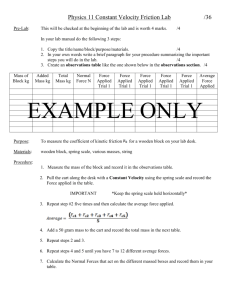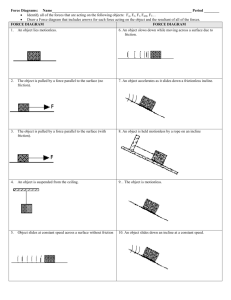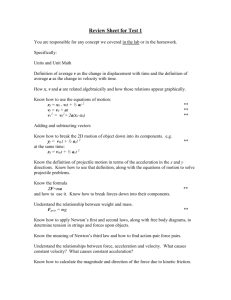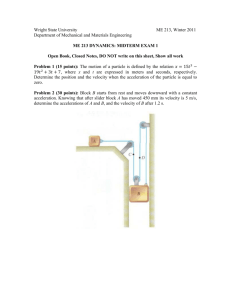Annotated Sample Honors Physics Problems-1
advertisement
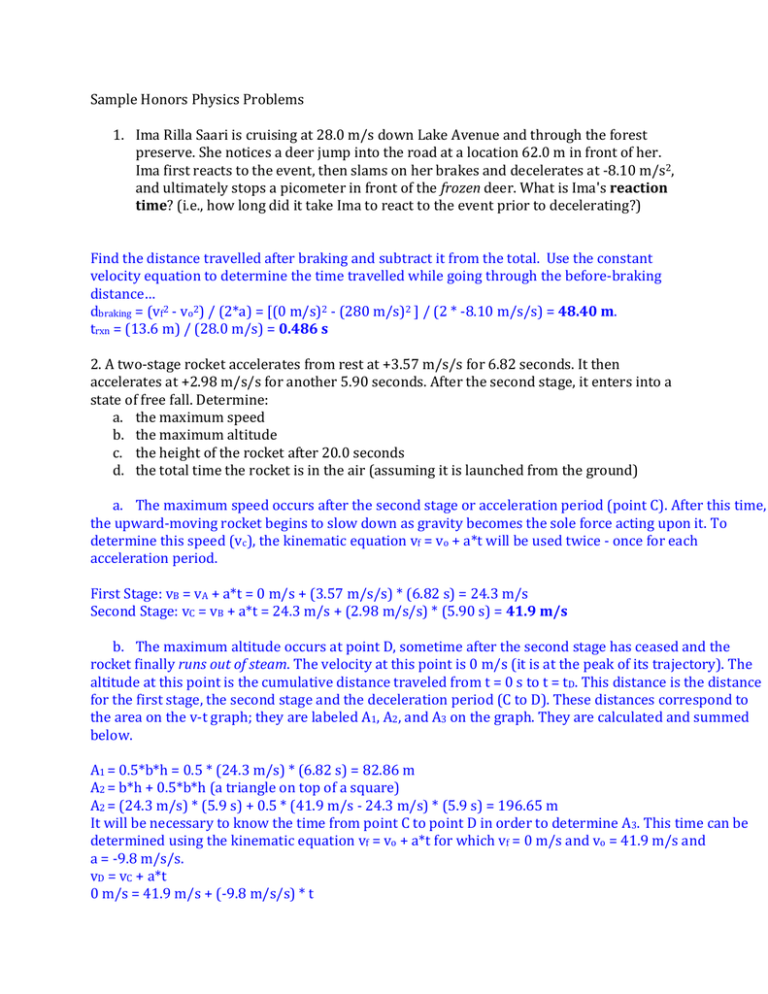
Sample Honors Physics Problems 1. Ima Rilla Saari is cruising at 28.0 m/s down Lake Avenue and through the forest preserve. She notices a deer jump into the road at a location 62.0 m in front of her. Ima first reacts to the event, then slams on her brakes and decelerates at -8.10 m/s2, and ultimately stops a picometer in front of the frozen deer. What is Ima's reaction time? (i.e., how long did it take Ima to react to the event prior to decelerating?) Find the distance travelled after braking and subtract it from the total. Use the constant velocity equation to determine the time travelled while going through the before-braking distance… dbraking = (vf2 - vo2) / (2*a) = [(0 m/s)2 - (280 m/s)2 ] / (2 * -8.10 m/s/s) = 48.40 m. trxn = (13.6 m) / (28.0 m/s) = 0.486 s 2. A two-stage rocket accelerates from rest at +3.57 m/s/s for 6.82 seconds. It then accelerates at +2.98 m/s/s for another 5.90 seconds. After the second stage, it enters into a state of free fall. Determine: a. the maximum speed b. the maximum altitude c. the height of the rocket after 20.0 seconds d. the total time the rocket is in the air (assuming it is launched from the ground) a. The maximum speed occurs after the second stage or acceleration period (point C). After this time, the upward-moving rocket begins to slow down as gravity becomes the sole force acting upon it. To determine this speed (vc), the kinematic equation vf = vo + a*t will be used twice - once for each acceleration period. First Stage: vB = vA + a*t = 0 m/s + (3.57 m/s/s) * (6.82 s) = 24.3 m/s Second Stage: vC = vB + a*t = 24.3 m/s + (2.98 m/s/s) * (5.90 s) = 41.9 m/s b. The maximum altitude occurs at point D, sometime after the second stage has ceased and the rocket finally runs out of steam. The velocity at this point is 0 m/s (it is at the peak of its trajectory). The altitude at this point is the cumulative distance traveled from t = 0 s to t = tD. This distance is the distance for the first stage, the second stage and the deceleration period (C to D). These distances correspond to the area on the v-t graph; they are labeled A1, A2, and A3 on the graph. They are calculated and summed below. A1 = 0.5*b*h = 0.5 * (24.3 m/s) * (6.82 s) = 82.86 m A2 = b*h + 0.5*b*h (a triangle on top of a square) A2 = (24.3 m/s) * (5.9 s) + 0.5 * (41.9 m/s - 24.3 m/s) * (5.9 s) = 196.65 m It will be necessary to know the time from point C to point D in order to determine A3. This time can be determined using the kinematic equation vf = vo + a*t for which vf = 0 m/s and vo = 41.9 m/s and a = -9.8 m/s/s. vD = vC + a*t 0 m/s = 41.9 m/s + (-9.8 m/s/s) * t t = 4.28 s Now A3 can be determined using the v-t graph. The area is a triangle and is calculated as A3 = 0.5*b*h = 0.5 * (41.9 m/s) * (4.82 s) = 89.57 m The maximum altitude is the sum of the three distances (areas) Max. altitude = 82.86 m + 196.65 m + 89.57 m = 369 m c. When the rocket reaches point D, the time is 17.0 seconds. The altitude at 20.0 seconds will be the 369 meters risen above the launch pad from point A to point D minus the distance fallen from the peak from 17.0 to 20.0 seconds. This distance would be represented by a negative area on the velocity-time graph. The area is a triangle and can be computed if the velocity at 20 seconds is known. It can be calculated using a kinematic equation and then used to determine the area of a triangle. Alternatively, a kinematic equation can be used to determine the distance fallen during these 3.0 seconds. The work is shown below: d = vo* t + 0.5*a*t2 = 0.5 * (-9.8 m/s/s) * (3.0 s)2 = 44.1 m The altitude at 20 seconds is therefore the ~369 m risen in the first 17 seconds minus the ~44 m fallen in the next 3 seconds. The answer is 325 m. d. The rocket rises 369 m in the first 17.0 seconds. In the time subsequent of this, the rocket must fall 369 meters. The time to fall 369 m can be found from the same kinematic equation used in part c. d = vo* t + 0.5*a*t2 -369 m = 0.5 * (-9.8 m/s/s) * t2 t = 8.68 seconds This time can be added onto the 17.0 seconds to determine the time at which the rocket lands: 25.7 seconds. 3. In a 200.0-m relay race (each leg of the race is 50.0 m long), one swimmer has a 0.450 second lead and is swimming at a constant speed of 3.90 m/s towards the opposite end of the pool. What minimum speed must the second swimmer have in order to catch up with the first swimmer by the end of the pool? Both swimmers swim the same distance (50 m) at constant speed. Swimmer A (who was just arbitrarily named) gets a 0.450 second head start. So swimmer B must travel faster in order to finish the race in less time than swimmer A. First, the time required of swimmer A to complete the 50.0 m at 3.90 m/s can be computed. The time is tA = d/vA = (50.0 m) / (3.90 m/s) = 12.82 s Thus, swimmer B must finish the same 50.0 m in 12.37 seconds (12.82s - 0.45 s). So the speed of swimmer B can be computed as vB = d/tB = (50.0 m) / (12.37 s) = 4.04 m/s 4. A 1250-kg small aircraft decelerates along the runway from 36.6 m/s to 6.80 m/s in 5.10 seconds. Determine the average resistive force acting upon the plane. (Assume that its engine/propeller makes no contributes to its forward motion). The acceleration is not given but determinable from the kinematic information. vi = 36.6 m/s, vf = 6.80 m/s, and t = 5.10 s The acceleration of the object is the velocity change per time: a = Delta v / t = (6.80 m/s - 36.6 m/s) / (5.10 s) = -5.84 m/s/s or 5.84 m/s/s, left. This acceleration can be used to determine the net force: Fnet = m•a = (1250 kg) • (5.84 m/s/s, left) = 7.30 x 103 N, left The friction forces (surface and air) provide this net force and are equal in magnitude to this net force. 5. A tow truck exerts a 18300-N force upon a 1210 car to drag it out of a mud puddle onto the shoulder of a road. A 17900 N force opposes the car's motion. The plane of motion of the car is horizontal. Determine the time required to drag the car a distance of 6.90 meters from its rest position. Upon neglecting air resistance, there are four forces acting upon the object. The up and down forces balance each other. The acceleration is rightward (or in the direction of the applied force) since the rightward applied force is greater than the leftward friction force. The horizontal forces can be summed as vectors in order to determine the net force. Fnet = ·Fx = 18300 N, right - 17900 N, left = 400 N, right The acceleration of the object can be computed using Newton's second law. ax = ·Fx / m = (400 N, down) / (1210 kg) = 0.3306 m/s/s, right This acceleration value can be combined with other known kinematic information (vi = 0 m/s, d = 6.90 m) to determine the time required to drag the car a distance of 6.9 m. The following kinematic equation is used; substitution and algebra steps are shown. d = vi • t + 0.5 •a • t2 d = vi • t + 0.5 •a • t2 6.90 m = 0.5 • (0.3306 m/s/s) • t2 6.90 m / (0.5 • 0.3306 m/s/s ) = t2 41.4 = t2 6.46 s = t 6. Sammy Sosa clubs a homerun which sails 421 feet and lands on an apartment balcony located a vertical distance of 59.0 feet above the level of the ball-bat contact location. An observer times the flight to the balcony to take 3.40 seconds. (a) Determine the velocity (magnitude and angle) at which the ball leaves the bat. (b) Determine the speed of the ball (in miles/hour) when it lands in the bleachers. Given: 1.00 m/s = 2.24 mi/hr; 1.00 meter = 3.28 feet. (a) For any projectile problem, it always a wise idea to begin the solution with a listing of known and unknown information in an "x-y table." This is shown below. Horizontal Motion x = 421 ft = 128.35 m (horiz. distance to balcony) vix = ??? ax = 0 m/s/s (true for all projectiles) t = 3.40 s (the ball is a projectile for this long) Vertical Motion y = 59.0 ft = 17.99 m (vert. distance to balcony) viy = ??? ay = -9.8 m/s/s (true for all projectiles) t = 3.40 s (the ball is a projectile for this long) Note that the time of flight is known. Time is a scalar quantity and has no directional component associated with it; one cannot refer to the horizontal time or the vertical time. It is listed in both tables since it can be used with kinematic equations for both the x- and the y-direction. Since three pieces of x-information are known, an x-equation can be employed to find the initial horizontal velocity. One useful equation is x = vix*t + 0.5*ax*t2 The initial horizontal velocity (vix) is 37.751 m/s. There are also three pieces of y-information known. Thus, a y-equation can be used to determine the initial vertical velocity (viy). A good equation is y = viy*t + 0.5*ay*t2 Plugging a chugging the above values into this equation yields an initial vertical velocity (viy) value of 21.951 m/s. The ball leaves Sammy Sosa's bat moving upward with a speed of 21.951 m/s and moving horizontally with a speed of 37.751 m/s. These two components of the initial velocity can be used to determine the initial velocity and angle of the baseball after contact with the bat. A diagram is shown at the right. The initial velocity of the ball is represented by the hypotenuse of a right triangle with sides equal to the component values. Thus the Pythagorean theorem can be used to determine the initial velocity of the baseball. vi 2 = (vix)2 + (viy) 2 vi2 = (37.751 m/s)2 + (21.951 m/s)2 vi 2 = 1906.97 m2/s2 vi = SQRT (1906.97 m2/s2 ) = 43.669 m/s The angle (theta) of the initial velocity can be determined using a trigonometric function. The tangent function is used here. Tangent(theta) = opposite / adjacent Tangent(theta) = (21.951 m/s) / (37.751 m/s) = 0.58145 Theta = Invtan (0.58145) = 30.176 degrees (b) In part (a) of this problem, the initial horizontal velocity was determined to be 37.751 m/s. For projectiles, this horizontal velocity does not change during the flight of the projectile. Thus, the projectile strikes the balcony moving with a final horizontal velocity (vfx) of 37.751 m/s. If the final vertical velocity (vfy) can be determined, then it can be used with the vfx value to determine the final velocity (vf). Several kinematic equations are useable for finding the final vertical velocity (vfy). The following equation will be used: vfy = viy + ay•t vfy = 21.951 m/s + (-9.8 m/s/s)•(3.4 s) vfy = 21.951 m/s - 33.32 m/s vfy = -11.369 m/s With the x- and y-components of the final velocity (vf) known, the Pythagorean theorem can be used to determine the final velocity value. A diagram is shown at the right and the calculations are shown below. vf 2 = (vfx)2 + (vfy) 2 vf2 = (37.751 m/s)2 + (-11.369 m/s)2 vf 2 = 1554.41 m2/s2 vf = SQRT (1554.41 m2/s2) = 39.43 m/s This value can be converted to miles/hour using the fact that 1.00 m/s = 2.24 mi/hr. The answer to part b is 88.3 mi/hr. 7. An unfortunate accident occurred on the toll way. A driver accidentally passed through a faulty barricade on a bridge (quite unfortunately). and landed in a pile of hay (quite fortunately). Measurements at the accident scene reveal that the driver plunged a vertical distance of 8.26 meters. The car carried a horizontal distance of 42.1 meters from the location where it left the bridge. If the driver was in a 65 mi/hr speed zone, then determine the amount by which the driver was exceeding the speed limit at the time of the accident. Assume that the contact with the barricade did not slow the car down. (1.00 m/s = 2.24 mi/hr) This is an example of a horizontally-launched projectile problem. Like all projectile problems, the best means of starting the problem is to list the known values for each of the variables in the kinematic equations. It is helpful to organize the information into two columns - a column of known horizontal information and a column of known vertical information. Horizontal Motion x = 42.1 m (the horizontal distance which is traveled) vix = ??? m/s ax = 0 m/s/s (true for all projectiles) Vertical Motion y = -8.26 m (it falls down from the cliff to the grou viy = 0 m/s (it is horizontally launched) ay = -9.8 m/s/s (true for all projectiles) Since three pieces of y-information are now known, a y-equation can be employed to find the time. One useful equation is y = viy*t + 0.5*ay*t2 in which case there will be two solutions: t = 1.2983 s and t = -1.2983 s. A full parabola which follows the above function would have two locations where the y coordinate is -8.26 m. One would be "forward in time" at 1.2983 seconds; and the other solution is at a location traced "backwards in time" from the launch time. Of course, the positive answer is the one which we need; it can can be used to determine the initial horizontal velocity (vix). Use the equation: x = vix*t + 0.5*ax*t2 where t = 1.2983 s, ax = 0 m/s/s and x = 42.1 m. Plugging a chugging the above values into this equation yields the answer of 32.426 m/s. This is the speed at which the car leaves the bridge at the start of its projectile motion. Converting this to mi/hr involves multiplying by the (2.24 mi/hr) / (1 m/s) conversion ratio. The result is 72.6 mi/hr. (In reality, the car was traveling faster than this speed since the collision with the guard rail likely slowed the car down before it exited the bridge and began its projectile motion.) 8. Splash Mountain at Disney World in Orlando, Florida is one of the steepest water plume rides in the United States. Occupants of the boat fall from a height of 100 feet (3.2 ft = 1 m) down a wet ramp which makes a 45 degree angle with the horizontal. Consider the mass of the boat and its occupants to be 1500 kg. The coefficient of friction between the boat and the ramp is 0.10. Determine the frictional force, the acceleration, the distance traveled along the incline, and the final velocity of the boat at the bottom of the incline. This is a multi-part inclined plane problem. Like all problems, it should begin with a free-body diagram. If this is where the difficulty lies for you, then take some time to review inclined planes. The friction force opposes the motion of the boat. If the + x direction is defined as down and along the incline (as shown at the right) then the net force can be computed by the expression F|| - Ffrict. The parallel component of the weight vector (m•g•sin theta) is 10395 N. The Ffrict force is computed by multiplying the coefficient of friction (0.10) by the normal force (Fnorm). The normal force is balancing Fperp (m•g•cos theta) and is equal to it. So Fnorm = 10395 N and Ffrict = 1039.4 N. The net force (Fnet = F|| - Ffrict ) is 9356 N; and the acceleration is Fnet/m or 6.24 m/s/s. Once the Newton's laws analysis has been completed and the acceleration determined, the kinematics portion of the problem can be tackled. First, determine the distance along the incline from the height of the hill and the angle of incline. The height of 100 ft is equivalent to 31.25 m; the distance along the incline is 44.19 m [found from (31.25 m)/sin (45)]. The final velocity is found using the acceleration, distance and a kinematic equation: vf2 = vo2 + 2•a•d vf2 = (0 m/s)2 + 2•(6.24 m/s/s)•(31.25 m) = 551.28 m2/s2 vf = 23 m/s 9. At last year's Homecoming Pep Rally, Trudy U. Skool (attempting to generate a little excitement) slid down a 42.0 degree incline from the sports dome to the courtyard below. The coefficient of friction between Trudy's jeans and the incline was 0.650. Determine Trudy's acceleration along the incline. Begin with a free-body diagram. When the mass is not known, the problem-solving strategy involves inserting m into the equation as an unknown variable and proceeding with the solution. It is likely that in a subsequent step of the problem that the m will cancel and the acceleration can be determined without knowing m. The net force is found by the expression F|| - Ffrict. The parallel component of the weight vector is m•g•sin(theta). The Ffrict force is computed by multiplying the coefficient of friction (mu) by the normal force (Fnorm). The normal force is balancing Fperp and is equal to m•g•cos(theta). So Fnorm = m•g•cos(theta) and Ffrict = µ•m•g•cos(theta). The net force is m•g•sin(theta) - µ•m•g•cos(theta). The acceleration is Fnet/m or [m•g•sin(theta) - µ•m•g•cos(theta)]/m. Note that there is an m in both terms in the numerator and a m in the denominator. The masses cancel and the equation reduces to a = [g•sin(theta) - µ•g•cos(theta)] By substitution of the given values into the equation, it can be shown that a = 1.82 m/s. 10. A 1.72-kg block of soft wood is suspended by two strings from the ceiling. The wood is free to rotate in pendulum-like fashion when a force is exerted upon it. A 8.50-g bullet is fired into the wood. The bullet enters the wood at 431 m/s and exits the opposite side shortly thereafter. If the wood rises to a height of 13.8 cm, then what is the exit speed of the bullet? The difficulty of this problem lies in the fact that information from other units (work and energy) must be combined with the momentum information from this unit to arrive at a solution to the problem. In this scenario there is a collision between a stationary block of wood and a moving bullet. The impulse causes the block of wood to be set into motion and the bullet to slow down. Momentum can be assumed to be conserved. Once set into motion, the block of wood rises in pendulum-like fashion to a given height. Its energy of motion (kinetic energy) is transformed into energy of vertical position (potential energy). The post-collision speed of the wood can be determined using energy conservation equations. To begin the solution, the final height of the wood is used to determine the post-collision speed of the wood. KEinitial = PEfinal 0.5 • mwood •vwood2 = mwood • g • hwood vwood2 = 2 • g • hwood vwood = SQRT(2 • g • hwood) vwood = SQRT[2 • (9.8 m/s2) • (0.138 m)] vwood = SQRT[2.7048 m2/s2] vwood = 1.6446 m/s Immediately following the emergence of the bullet from the wood, the wood block is moving with a speed of 1.6446 m/s. Knowing this, momentum conservation can be applied to determine the post-collision speed of the bullet. mwood • vwood-before + mbullet • vbullet-before = mwood • vwood-after + mbullet • vbullet-after where vwood-before = 0 m/s; vbullet-before = 431 m/s; vwood-after = 1.6446 m/s; vbullet-after = ??? (1.72 kg) • (0 m/s) + (0.00850 kg) • (431 m/s) = (1.72 kg) • (1.6446 m/s) + (0.00850 kg) • vbullet-after (To simplify the work, the units will be dropped from the solution in the next several steps. Once a vbullet-after value is found, its units will be in m/s, consistent with the units stated in the above line.) 0 + 3.6635 = 2.8288 + 0.00850 • vbullet-after 0.8347 = 0.00850 • vbullet-after (0.8347) / (0.00850) = vbullet-after vbullet-after = 98.205 m/s = ~98.2 m/s 11. In a physics lab, the pitching speed of a student is determined by throwing a baseball into a box and observing the box's motion after the catch. A measurement of the the distance the box slides across a rough surface of known coefficient of friction will allow one to determine the pre-impact speed of the pitched ball. If a 0.256-kg ball hits a 3.46-kg box and the ball and box slide a distance of 2.89 meters across a surface with a coefficient of friction of 0.419, then what is the pre-impact speed of the pitched ball? This is another example of a problem in which information from other units (work and energy or Newton's laws and kinematics) must be combined with the momentum information from this unit to arrive at a solution to the problem. There is a collision between a stationary box and a moving baseball that causes the baseball to slow down and the box to speed up. It is a perfectly inelastic collision with the baseball remaining lodged in the box and the two objects moving together with the same post-collision speed. After the collision occurs, the baseball and box slide a given distance across a rough surface to a final resting position. The coefficient of friction between the box and the surface is given. This latter information (sliding distance and mu value) can be used to determine the post-collision speed of the box and baseball. Once found, momentum conservation can be applied to the collision to determine the pre-collision speed of the baseball. Work and energy principles will be used to analyze the motion of the box/baseball system sliding to a stop. (Newton's laws and kinematics could just as easily been used). Immediately following the collision, the box/baseball system has kinetic energy. Friction does work upon the box/baseball system to bring to a final resting position, characterized by zero kinetic energy. The motion occurs across a level surface, so there is no potential energy change of the box. The work done by friction is equal to the kinetic energy change of the box/baseball system. Wfrict = Delta KE Ffrict • d • cos(Theta) = KEfinal - KEinitial (mu •Fnorm) • d • cos(180) = 0.5 • m •vfinal2 - 0.5 • m •vinitial2 - (mu • m • g) • d = 0 - 0.5 • m • vinitial2 mu • g • d = 0.5 • vinitial2 2 •mu • g • d = vinitial2 SQRT(2 • mu • g • d) = vinitial where mu = 0.419; d = 2.89 m; and g = 9.8 m/s2 vinitial = SQRT[2 • (0.419) • (9.8 m/s2 ) • (2.89 m)] vinitial = SQRT[23.734 m2/s2] vinitial = 4.8717 m/s Immediately following the collision, the box/baseball system begins moving with a speed of 4.8717 m/s. Now momentum conservation can be applied to determine the pre-collision speed of the baseball. mbaseball • vbaseball-before + mBox • vBox-before = mbaseball • vbaseball-after + mBox • vBox- after (0.256 kg) • vbaseball-before + (3.46 kg) • (0 m/s) = (0.256 kg) • (4.8717 m/s) + (3.46 kg) • (4.8717 m/s) (To simplify the solution, the units will be dropped from the solution in the next several steps. Once a vbaseball-before value is found, its units will be in m/s, consistent with the units stated in the above line.) 0.256 • vbaseball-before = 1.2472 + 16.8562 0.256 • vbaseball-before = 18.1033 vbaseball-before = (18.1033) / (0.256) vbaseball-before = 70.7 m/s 12. Pete Zaria applies a 11.9-Newton force to a 1.49-kg mug of root beer in order to accelerate it from rest over a distance of 1.42-m. Once released, how far will the mug slide along the counter top if the coefficient of friction is 0.728? Here is an instance in which there is only horizontal motion and a non-conservative force is doing work to change the kinetic energy of the mug. The entire motion will have to be divided into two parts - the part in which both friction and applied force act upon the mug (Pete is pushing it from position A to position B) and the part in which the mug is slowing down under the sole influence of friction (from position B to position C). The work-energy theorem (W = Delta KE) will be used to analyze each part. From position A to position B, Pete is pushing the mug and the net force upon the mug is simply the applied force minus the friction force (see free-body diagram below). From position B to position C, friction is the unbalanced force and acts as the net force (see free-body diagram below). The force of friction is related to the normal force (= m•g) and the coefficient of friction (0.728). The Ffrict is Ffrict = mu•Fnorm = (0.728) • (1.49 kg) • (9.8 m/s/s) = 10.6 N This means that the net force from A to B is 11.9 N - 10.6 N = 1.27 N. The net force from B to C is 10.6 N. From A to B, the work done equals the kinetic energy change. So the kinetic energy at position B is KEB = W = F • d • cos(theta) = (1.27 N) • (1.42 m) • cos(0 deg) = 1.80 J From B to C, the mug will lose this same amount of kinetic energy as friction works upon it to bring it to a stop. So the work done from B to C is -1.80 J. W = Change in KE F • d • cos(theta) = -1.80 J (10.6 N) • (d) • cos(180 deg) = -1.80 J - (10.6 N) • (d) = -1.80 J d = 0.170 m 13. Suzie Lovtaski has a mass of 49.7 kg. She is at rest on top of a hill with a height of 92.6 m and an incline angle of 19.2 degrees. She coasts down the hill to the bottom and eventually comes to a stop; she never uses her poles to apply a force. The coefficient of friction is 0.0873 along the hill and 0.527 along the horizontal surface at the bottom. What total distance will Suzie coast (include both incline and level surface)? This problem is very similar to question #12 and can be treated in much the same way. There is a non-conservative force - friction - doing work upon the skier. This force will alter the total mechanical energy of the skier. The equation to be used is KEi + PEi + Wnc = KEf + PEf If we designate the level area at the bottom of the slope as the zero level of potential energy, then PEf is 0 J. Since Suzie eventually stops (due to the effect of friction along the level area), the KEf is 0 J. And since Suzie starts from rest, KEi = 0 J. So the above equation becomes PEi + Wnc = 0 The Wnc term has two parts; there is friction doing along the inclined plane and friction doing work along the level surface. Since these two sections of the motion have different normal forces and friction coefficients (and therefore friction forces), they will have to be treated separately. The graphic below depicts the free-body diagrams and the means by which the friction force can be determined. By substituting values of mu and mass and g and theta into the above equations, one finds that the friction values are On Incline On Level Surface Ffrict = 40.2 N Ffrict = 257 N These forces act upon the skier over different distances. In the case of the inclined plane, the distance (d) can be computed from the given incline angle and the initial height. The relationship is depicted in the diagram below. The sine function is used to relate the angle to the initial height and the distance along the incline. In the case of the level surface, the distance is the unknown quantity (x) which this problem calls for. The distance d along the incline is d = hi / sin(theta) = 92.6 m / sin(19.2 deg) = 282 m Now substitutions can be made into the work-energy equation and algebraic manipulation can be performed to solve for x: PEi + Wnc = 0 PEi + Wincline + Wlevel = 0 (49.7 kg)•(9.8 m/s)•(92.6 m) + (40.2 N)•(282 m)•cos(180 deg) + (257 N)•(x)•cos(180 deg) = 0 J 45102 J - 11307 J - 257 x = 0 J 33795 J = 257 x 132 m = x 14. Two objects are located along the y-axis. Object A has a charge of +25 µC and is located at the origin. Object B has a charge of -16 µC and is located a distance of 62 cm above object This problem involves determining a location along the axis where two vectors are directed in opposite direction and have the same magnitude. At such a location the electric field created by object A equals the electric field created by object B. EA = EB kQA/RA2 = kQB/RB2 A diagram is always a useful way of approaching the problem. Since A is positively charged, the electric field created by A is directed away from it. Since B is negatively-charged, the electric field created by B is directed towards. Thus, some directional reasoning would lead to the conclusion that the location along the axis must be outside of the two charges. And since object B has the smaller charge and creates the smaller E field, the location will be closer to object B than to object A. That is, what object B lacks in terms of charge it must make up for in terms of distance in order to have an equal field to object A's. The results of this reasoning are shown in the diagram above. The location of 0 electric field is a distance of x cm from the -16 µC charge and a distance of 62+x cm from the +25µC charge. These distances and charge values can be inserted into the equation above and algebra can be used to solve for x. (Note that the + and - sign has been dropped from the equations; directional meaning has been accounted for in the reasoning above.) k•(25 µC)/(62 + x)2 = k•(16 µC)/(x)2 Divide each side through by k. (25 µC)/(62 + x)2 = (16 µC)/(x)2 Take the square root of each side of the equation and then cross-multiply. 5/(62 + x) = 4/x 5x = 4•(62 + x) = 248 + 4x x = 248 Since x represents the distance from object B and since object B is at a y-coordinate of 62 cm, the answer to the problem is 310 cm. 15. Three objects are located along the x-axis. Object A with a charge of +5.6 µC is located at the origin. Object B has a charge of -4.2 µC and is located at the -1.2 m location. Object C has a charge of +7.7 µC and is located at the +2.4 m location. Determine the magnitude and direction of the net electric force acting upon object A. Object A experiences two forces - the force of object B attracting it and pulling it leftward (FBA) and the force of object C repelling it and pushing it leftward (FCA). The diagram below depicts the situation and the forces. The net electric force upon object A is simply the vector sum of these two forces. The strategy involves computing each force (FBA and FCA ) individually and then adding them together as vectors. The calculations of the two forces are shown below. (Note that the + and - signs have been dropped from the values on the charge since the directional information has already been accounted for in the analysis above.) FBA = k•QA•QB/d2 = (9.0x109 N/m2/C2)•(5.6x10-6 C)•(4.2 x10-6 C)/(1.2 m)2 = 0.147 N, left FCA = k•QA•QC/d2 = (9.0x109 N/m2/C2)•(5.6x10-6 C)•(7.7 x10-6 C)/(2.4 m)2 = 0.067 N, left Now the net electric force on object A can be determined by adding the two forces resulting from the interactions with A and with B. The net force is 0.21 N, left. (0.214 N rounded to two significant digits)
